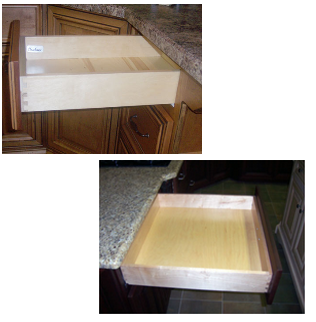 As you start your cabinet remodeling plans, it becomes clear early on that:
As you start your cabinet remodeling plans, it becomes clear early on that:
A) Similar looks are available in many price ranges
B) Not all cabinets are created equal (even if they look alike)
All cabinets are constructed of a few basic structural components – the box, which is the main portion or backbone of the cabinet (the part that looks like a box), the drawers, and the shelves. Where they differ are in materials, construction and customization options. Let’s take a look at the most common materials and construction basics you should be familiar with when looking at cabinet structure elements.
Common cabinet materials
Boxes, shelves and drawers are commonly made from the following materials:
Plywood – If you’re looking for a strong backbone for your cabinets, plywood is arguably the best (but also usually the more costly) option. Plywood is made up of layered thin sheets of wood veneer which are alternated and glued together. The finished result is a strong panel that minimizes expansion, contraction and splitting commonly found with solid wood. When it comes to cabinet boxes, ¾ inch thick plywood is generally used.
Medium-Density Fiberboard (MDF) –Created when high pressure and temperatures are applied to a mixture of wood fibers, wax and a resin binder. The end result is a fairly strong and uniform panel that is usually finished with paint, due to its smooth finish. While MDF is more comparable to plywood than particleboard, it is still somewhat susceptible to moisture-related damage. Another common complaint is that it emits the greatest amount of formaldehyde gas.
Particleboard – If price is your main concern, and you’re willing to compromise some durability, particleboard may be for you. This composite material is engineered from wood chips, sawmill shavings and sawdust bound together with an adhesive. Although it tends to be more uniform and smooth than plywood, it is also more prone to discoloration and expansion. If you’re looking into particleboard, there are different grades available, so make sure you talk to your supplier about the most durable options.
Drawer Construction
When it comes to drawer construction, they can be kept together in a few different ways – ranging from the least expensive options of gluing or stapling joints, or the more sturdy option of dovetailing. Dovetailed joints are formed when tenons (pins) on one joint interlock with mortises (notches/tails) on the other joint. While any of the above will hold the drawer together, dovetailed drawers are in it for the long haul.
What we offer
At Brakur, quality products are our priority. For this reason, we provide ¾” plywood on all finished ends of cabinetry with UV oven cured finished interiors and 5/8” Plywood ends on all raw ends of cabinetry with natural birch UV oven cured coated finished interiors. Our standard shelving consists of ¾” plywood with a birch UV oven cured coated finish. When it comes to drawers, Brakur utilizes plywood and dovetail solid wood drawers as a standard, which is commonly found as an upgrade through other suppliers. The end result, which can be verified by our satisfied client base, are strong, beautiful cabinets that are built to last.
If you have any questions about Brakur’s cabinetry construction, visit the construction section of our website, or don’t hesitate to contact our team – we’re always happy to help.

